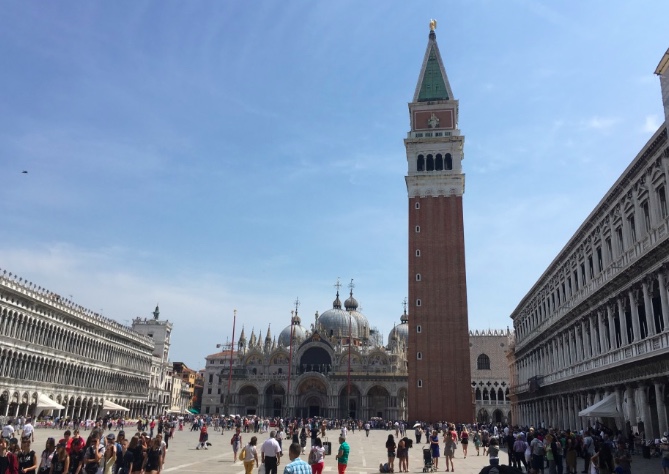
The tower is the Campanile of St. Mark, and the domed cathedral in the background is St. Mark’s Basilica. I have a story about each of these.
The Collapse of the Campanile
The campanile was built originally in the mid-16th century as a watchtower and lighthouse for the port, but at 9:45 in the morning in July 1902, it collapsed. Remarkably, no one was killed—except the caretaker’s cat.
The city council approved funds for reconstruction that same evening. The reconstruction was completed in 1912. Many of the original bricks were used. In fact, there was only one change: an elevator.
The Theft of St. Mark’s Body
This is the (probably apocryphal) tale of how Saint Mark became the patron saint of Venice and how the basilica acquired his body.
In 828 A.D., two Venetian merchants, Buono da Malamocco and Rustico da Torcello, arrived in Alexandria to do business. Alexandria at that time was under Muslim rule (although it had been ping-ponging back and forth between Byzantium and the Arabs for about two hundred years, with apparently a brief interlude in the hands of Spanish pirates). By 828, the Christian shrines in the city were falling apart due to a combination of lack of caretakers and theft of marble for new buildings.
When Buono and Rustico came to the shrine of Saint Mark to worship, they found it threatened with demolition. They decided to steal/rescue the saint’s body. (Why they didn’t just buy him from the Arabs, who couldn’t have cared less, I’ve never understood.)
They snuck the body of the nearby Saint Claudia into his shrine to cover the theft. Saint Mark they packed into a wicker basket. They covered the body with cabbage leaves and pork. Because Muslims consider pork unclean, none of the customs inspectors wanted to open the basket. Buono and Rustico carried the saint straight through customs shouting “Pork! Pork!” and loaded him aboard their ship.
They encountered various trials on their way back to Venice. Many times, they were run aground and had to depend on the aid of locals to make their ship seaworthy again. In thanks, they gifted them pieces of the saint’s body. (This sounds morbid to modern ears, but the trafficking of bits of saints was a righteous, not to mention lucrative, business in the 9th century.) This is why you find various towns between Alexandria and Venice boasting, I believe, two toe-bones, seven fingers, and three arms of Saint Mark.